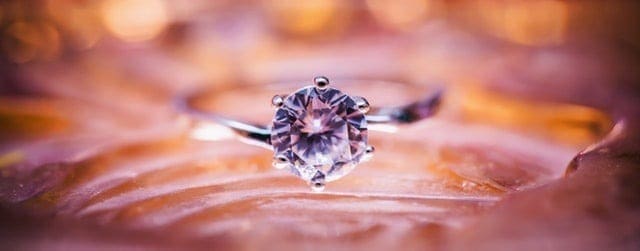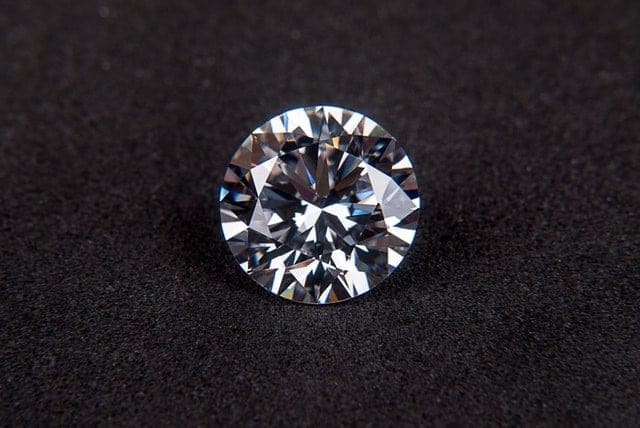You’ve met the one, you’ve fallen head over heels, and you’re ready to make it forever. You’ve toyed with hundreds of different proposal ideas, but regardless of involving the dog, family members, or rivers of flowers, it all comes back to the ring, and the diamond. To create the perfect ring, you’ve elected to look for a loose diamond to integrate into the piece. What you learn in this guide will help you not to lose your shirt in the process.
Lots of different vendors are available to choose from, but without guidance around the selection process, it can be a little daunting. There are lots of diamonds possible, and you need to understand the relevant factors at hand for choosing the perfect gem. Components of size, shape, cut quality, clarity, and color are all important to understand before selecting the perfect diamond for your special someone.
Vendors
We recommend James Allen and the Blue Nile as favorite vendors. They integrate full, detailed photography into their websites so that you can evaluate gems before you purchase them. This is extremely important for selecting a diamond that is “eye clean” (more on that below).
They sell diamonds certified by the most respected diamond grading labs (GIA & AGS), and they are tightly integrated with their diamond suppliers, so fulfillment hiccups are extremely rare.
Best of all, their profit margins are among the lowest in the industry. Whereas a classic bricks & mortar jewelry store needs to make at a minimum 25% profit just to get by, online diamond sellers thrive with much less.
Size
Have you and your partner had a conversation about expectations around the engagement ring? If not, we recommend that you do because it is a practical, straightforward way to know what her expectations are about the size of the diamond involved. If you cannot have a direct conversation with your partner, talk with her friends about what she likes to be as sure as possible.
Diamonds are measured in carat weight, and regardless of other qualities, a half carat diamond will not appear the same as a two-carat gem. The typical rule is the more significant, the better. Although, not all individuals will feel the same way. Factors like career, lifestyle, and recreational preferences can affect the size of diamond desired.
Having a dialogue about as many qualities of the ring as possible ahead of time will save time and anxiety when the process comes around. In fact, some people shop openly with their partners when selecting an engagement ring. Transparency leaves less room for disappointment and often results in increased satisfaction with the final product. It is easier to be on the same page before starting the selection process rather than deciding to do the whole thing again due to any miscommunication. After you and your partner determine a carat size for the diamond, you’ll move on to shape.
Shape
Diamonds come in Round Brilliant, Oval, Pear-shaped, Marquise cut, Cushion cut, Emerald cut, Princess cut, Asscher cut, and Radiant cut shapes. Pear-shaped refers to a pointed top with a rounded bottom, while Marquise means pointed at both ends. A Cushion cut stone is a rounded rectangle or square, while an Emerald cut has beveled, squared edges and a stepped-cut bottom. Asscher is a square version of the Emerald cut. The Princess cut appears square, but has brilliant faceting on the bottom. Lastly, a Radiant cut describes a rectangular brilliant shape.
Rounds are by far the most popular choice, but there is no shortcut to understanding your partner’s shape preference. This is entirely a matter of personal aesthetic taste and should be discussed before the selection process if at all possible. If not, this would be another factor worthy of consulting friends and family close to your partner likely to know about her preferences.
Cut Quality
The cut quality of a diamond is one of the more complicated factors. Diamond cut is distinct from diamond shape; it means how well-proportioned a diamond is. Cut is based on several different components, including proportions, facets, brilliance, fire, scintillation, and finishing details. Proportions refer to the table, depth, and width of a diamond. Later we’ll talk about the significance of dimensions.
Facets are different sides of the gem; there should be enough of them to reflect light well. Brilliance refers to how well the jewel reflects white light back to the eye, whereas fire refers to how well-colored light is reflected. Scintillation is the “glitter effect” and describes how well the stone sparkles.
Now we’ll discuss the significance of different diamond dimensions. These break down into table, width, and depth. Diamond table percentage means the ratio of top surface area to the width of the gem. If the stone is too broad, it will not sparkle as well as one with an ideal table. Width is a measure of length to width ratio, and depth is the height of the diamond. Height divided by width gives you the depth percentage.
Diamond shape refers to the actual outline or silhouette of the gem, whereas diamond cut describes the facets, symmetry, dimensions, and reflective abilities of the gem. The diamond cut affects the way that the stone can reflect light through both brilliance and fire, taking both white and colored light into account.
Shallow diamonds are shorter and often broader, meaning that light does not make its way back up to the top of the gem. Similarly, tall, deep diamonds are usually skinner, meaning that light is refracted in the same manner. A well-proportioned diamond allows light to reflect in a “U” shape down and back up through the diamond. Understanding the most advantageous shape has lots to do with recognizing appropriate angles in the gem.
Some vendors will utilize a grading system on all diamonds, and some will only categorize round diamonds rather than those with other shapes. Rating systems can differ widely from one another. Others are based solely on stone measurements without taking different qualities into account.
The Gemological Institute of America (GIA) grades round diamonds on a scale with Excellent at the top. Ratings are as follows:
Excellent diamonds are proportionate and able to reflect light back through the table in the “U” shape mentioned previously, which creates the maximum amount of fire and brilliance possible from the stone.
Very Good diamonds are similar to Excellent diamonds, and often can only be distinguished by a professional eye. Most light is reflected back through the stone’s table, and there is a significant amount of both fire and brilliance. Good diamonds are notorious for brilliance and sparkle, as opposed to fire. These are more distinguishable from Excellent stones and are available at a lower cost. Fair diamonds mean less sparkle and brilliance due to light escaping from sides and bottom of the gem. These may be appropriate for smaller diamonds or accent gems around the sides of a ring. Lastly, Poor diamonds are rarely brilliant due to most all of the light escaping from different sides of the stone.
Fifty-five percent of diamonds get a rating of Excellent through the GIA system, although twenty-five to thirty percent of those stones is rejected by retailers or other professionals due to imperfections of different types. We recommend looking at the highest rated diamonds if you are searching for a round shape. Otherwise, consider looking at lower estimated stones or even disregarding the systems altogether.
You may risk discounting the perfect gem based on the fact that it didn’t make it into a particular category on a fluke. Once you’ve gotten past size, shape, and cut class, you’ll focus on clarity.
Clarity
Diamonds take billions of years to form down in the Earth’s mantle layer. By the time they are complete, few emerge without imperfections. Often, they are cloudy or tinted yellowish or brown from their time in the Earth’s crust. Colorless, transparent diamonds are the most highly rated and the rarest. The clarity rating system ranges from Internally Flawless, Very Very Small, Very Small, Small Inclusions and then Inclusions.
It takes until the second class of Very Small Inclusions for a standard jeweler’s microscope to be able to find imperfections without scouring. Most people buy diamonds that are too clear to be considered a smart purchase when most classes have inclusions that cannot be seen whatsoever to the naked eye. Often, Asscher and Emerald cuts show inclusions the clearest. Clarity means that choosing suitable vendors like James Allen and Brian Gavin Diamonds is critical. The photography available needs to be clear and high-quality enough to scout any imperfections.
Even classes of Slight Inclusions can be “eye clean,” meaning that there are no imperfections visible to the naked eye. These diamonds offer the best value. An eye clean lower clarity diamond will look identical to a flawless diamond to the naked eye assuming all else is equal.
Color
The last of the diamond selection facets is color. The trick to color selection is making sure the diamond looks white compared to the setting that it is mounted in. A yellow or rose gold setting may make a yellower diamond appear white, while the same diamond in a white gold setting may look slightly yellow. A purposely colored diamond may be beautiful, while a diamond intended to be clear that shines yellow is not as appealing.
The GIA grades diamonds on a color scale from D to Z. The categories are as follows:
D, E, and F are colorless diamonds with almost no color imperfections. These are often set in white or neutral settings to showcase their colorless quality. G through J diamonds may have a very faint tint invisible to the naked eye and are often also set in white gold. Price for this category usually drops up to fifteen percent from the first. K through M diamonds can be discerned as slightly yellow, and are typically set in yellow gold to contrast. They can be as little as half as much as the first category. N through R diamonds have a very light tint and are not recommended. S-Z diamonds are part of the light tint category and appear slightly brown or yellow. These are also not recommended.
Rather than dedicating money to diamonds of the highest color grade, it is smarter to spend time considering cut quality for maximum value.
Size, shape, cut quality, clarity, and color all affect the quality and choice of a suitable diamond for your particular partner. Discussion about as many of these factors as possible before the selection process will help drastically. You may even consider letting your partner in on the fun.
Reach Out to Us
Remember that throughout your selection process you are always welcome to contact us for a free professional opinion about diamond selection. We have been in the business for many years, and select hundreds of diamonds every month and have never charged a single penny for our services. The process comes second nature to us, but we recognize that all of the factors involved can make it an intimidating one for a first timer. Consider us a comforting, confident resource during your search for the perfect size, shape, cut quality, rating, clarity, and color.





